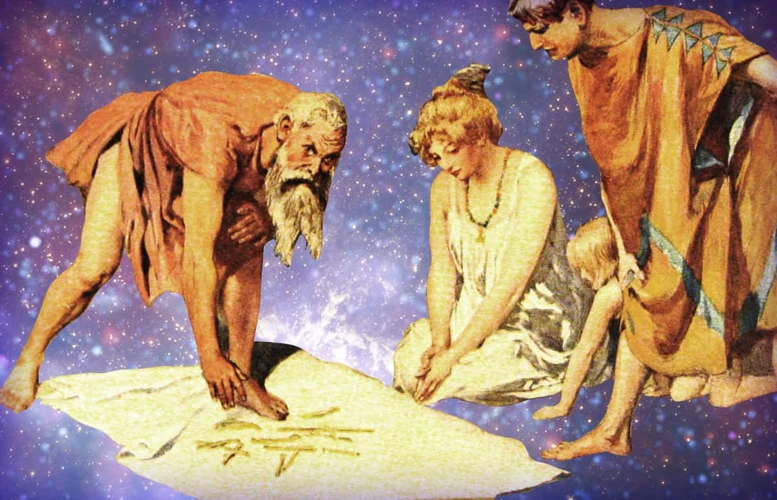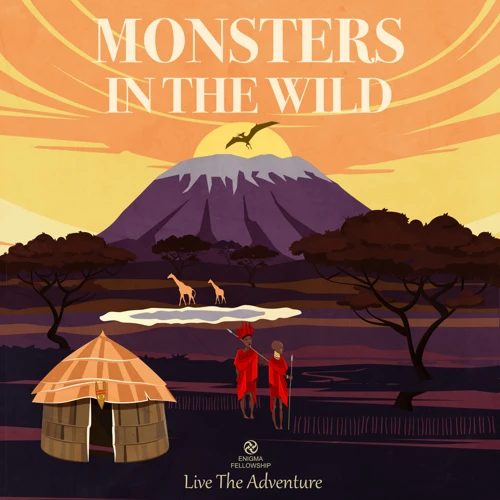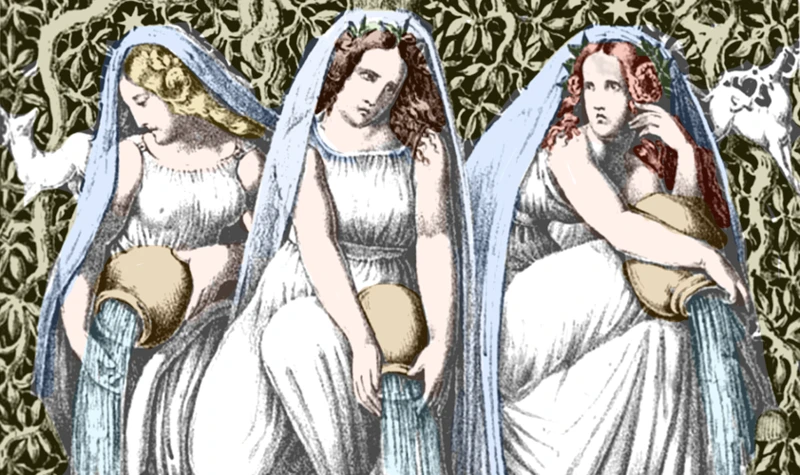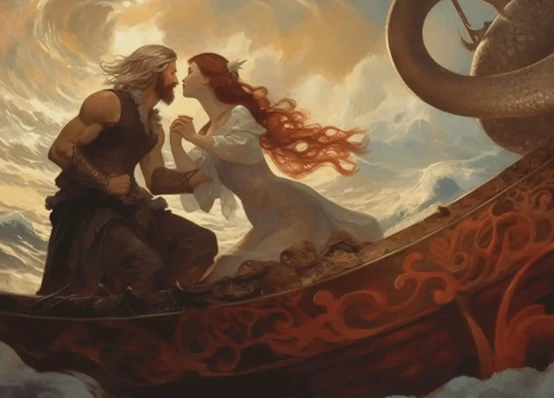Throughout history, humans have been captivated by mythical creatures and the rich tapestry of folklore that surrounds them. In Norse mythology, the relationship between humans and mythical creatures is especially intricate and compelling. From gods and goddesses to tricksters and shapeshifters, these myths and legends have shaped the beliefs and culture of the Norse people for centuries. In this article, we will delve into the origins of Norse mythology, explore the role of mythical creatures in this ancient belief system, examine the interactions between humans and these fantastical beings, and uncover the lasting influence of Norse mythology on culture today. Join us on a journey to uncover the marvels of the intricate relationship between humans and mythical creatures in Norse mythology.
The Origins of Norse Mythology

The Origins of Norse Mythology can be traced back to a time long before the Viking Age. The ancient Norse people, who inhabited the regions of modern-day Scandinavia, relied heavily on oral traditions to pass down their myths and legends from one generation to the next. These stories were intricately woven into the fabric of their daily lives, providing explanations for natural phenomena, moral guidance, and a sense of collective identity. The earliest forms of Norse mythology can be found in the pre-Christian era, where it coexisted alongside pagan practices and rituals. Over time, as the Norse people came into contact with other cultures and civilizations, their mythology evolved and incorporated new elements, while still maintaining its distinctive Nordic flavor. It is important to note that the exact origins of Norse mythology are elusive, as much of it was transmitted orally and only later recorded in written form. However, its influence and significance cannot be denied, as it continues to captivate the hearts and imaginations of people worldwide. To better understand the origins of Norse mythology, it is essential to explore the cultural and historical context in which it emerged, as well as the specific myths and tales that laid the foundation for this extraordinary belief system. (Source: Norse Mythology in the Viking Age)
The Role of Mythical Creatures in Norse Mythology

Mythical creatures play a significant role in Norse mythology, each with their own unique characteristics and purposes. These creatures are diverse and multifaceted, often embodying the forces of nature, elements of chaos, or acting as guardians and guides for humans and gods alike. Gods and goddesses, such as Odin, Thor, Freya, and Loki, interact and often assume the forms of these creatures, showcasing their power and symbolizing the intricate relationship between humans and deities. Beings of light and darkness, such as the fair elves and malevolent trolls, represent the contrasting forces of good and evil within the Norse mythological world. Additionally, guardians and protectors, such as the valkyries and the mighty giants, defend the realms and individuals against external threats. Tricksters and shapeshifters, like Loki, bring unpredictability and mischief into the stories, challenging the status quo and serving as catalysts for change. These mythical creatures not only provide narrative depth and complexity but also convey moral lessons and philosophical concepts inherent in Norse mythology. (Source: The Role of Ragnarok in Norse Mythology)
Gods and Goddesses
In Norse mythology, Gods and Goddesses play a central role in the intricate tapestry of belief and storytelling. These powerful deities are revered and worshipped by humans, embodying various aspects of nature, wisdom, and divine power. The Norse pantheon includes well-known figures such as Odin, the all-father and ruler of Asgard, Thor, the god of thunder and protector of mankind, and Freya, the goddess of love, beauty, and fertility. Each deity possesses unique qualities and responsibilities, contributing to the balance and order of the cosmos. Odin, for example, is associated with wisdom, courage, and magic, whereas Thor is seen as a mighty warrior and champion of humans, wielding his iconic hammer Mjölnir. Freya, on the other hand, is revered for her sensuality, representing the cycles of life and death. These gods and goddesses are not only figures of worship but also engage in various adventures and conflicts, adding depth and complexity to Norse mythology. One notable aspect of their existence is their connection to the afterlife, as they are believed to govern the realms of Valhalla and Folkvangr, where slain warriors are honored. The gods and goddesses of Norse mythology embody the triumphs, struggles, and virtues that humans admire and seek to emulate, making them essential characters in the intricate relationship between humans and mythical creatures. (Source: Norse Mythology and the Afterlife)
Beings of Light and Darkness
In Norse mythology, the pantheon of gods and goddesses is filled with a diverse array of beings, including those symbolizing both light and darkness. These Beings of Light and Darkness play crucial roles in the Norse cosmology, representing contrasting forces that shape the world. One prominent example is Baldur, the god of light, beauty, and purity. Revered for his radiant and benevolent nature, Baldur embodies the essence of goodness and is beloved by all. In contrast, there is Loki, the mischievous and shape-shifting god associated with chaos and trickery. Loki’s unpredictable nature and calculated mischief often bring about discord and challenging trials for both gods and humans alike. Another notable figure is Hel, the goddess of the underworld and ruler of the realm of the dead. Hel presides over a realm that exists outside the realms of the living, representing the darkness and mystery of death. These Beings of Light and Darkness serve as compelling embodiments of the complexities of human existence, showcasing the eternal struggle between order and chaos, good and evil. It is through their interactions and conflicts that Norse mythology explores profound themes of morality, fate, and the delicate balance between opposing forces. (Source: Norse Mythology Afterlife)
Guardians and Protectors
Guardians and Protectors hold a significant role in Norse mythology. These mythical creatures were entrusted with safeguarding various realms and beings. One prominent example is Heimdall, the watchful guardian of the gods. Heimdall possesses incredible senses and is known for his keen awareness and vigilance, often stationed at the boundaries of Asgard, the realm of the gods. Another notable guardian is the fearsome giantess, Skadi, who protects her mountainous domain and defends her autonomy. Skadi is a skilled huntress and an embodiment of strength and resilience, representing the power that comes from protecting one’s territory. The mighty Thor, known for his hammer Mjolnir, also assumes the role of a protector, defending both gods and humans against the forces of chaos and evil. Additionally, the Valkyries, fierce warrior-women chosen by the gods, acted as protectors of fallen heroes in battle, guiding them to the afterlife in Valhalla. These guardians and protectors in Norse mythology illustrate the importance placed on maintaining order, defending the realms, and upholding justice. They embody the values of courage, loyalty, and selflessness, serving as inspirations for individuals striving to protect what they hold dear.
Tricksters and Shapeshifters
Tricksters and shapeshifters play a fascinating and complex role in Norse mythology. These mythical creatures often possess the ability to transform their appearance, assuming various forms to deceive or outsmart others. One prominent example is the mischievous Loki, a shape-shifting god known for his cunning and unpredictable nature. Loki is a trickster figure who brings both chaos and innovation to the world of the gods. His shapeshifting abilities enable him to take on different forms, ranging from animals to objects, allowing him to navigate through various situations with wit and cunning. Loki’s tricks often lead to both humorous and dire consequences, showcasing the intricate relationship between mischief and consequences in Norse myth. Another well-known trickster figure in Norse mythology is the giant, Þjazi. Þjazi is notorious for his ability to transform into an eagle, and he uses this form to abduct the goddess, Idun, and her rejuvenating apples. Tricksters and shapeshifters, with their unpredictable nature and transformative powers, add an element of complexity and unpredictability to Norse mythology, challenging the perceptions of both gods and humans alike. It is through their actions and interactions that the intricate web of Norse mythology is woven, highlighting the constant interplay between order and chaos, and the importance of wit and adaptability in navigating the world of the gods.
The Interactions between Humans and Mythical Creatures

The interactions between humans and mythical creatures in Norse mythology are fascinating and complex. Heroes and their companions often embarked on epic quests, where they encountered a wide array of mystical beings. These encounters were not always adversarial; in fact, alliances were formed, and partnerships were forged. Additionally, battles were fought between humans and creatures, with each side showcasing their own unique abilities and strengths. Rituals and offerings were also an integral part of the interactions between humans and mythical beings, as humans sought their favor or protection. One significant element of Norse mythology is Yggdrasil, the World Tree, which served as a bridge between realms, allowing for communication and interaction between humans and mythical creatures. These interactions played a crucial role in shaping the Norse belief system and contributed to the rich tapestry of their stories and legends, showcasing the intricate relationship between humans and mythical creatures in this captivating mythology.
Heroes and Their Companions
In Norse mythology, Heroes and Their Companions hold a special place in the intricate relationship between humans and mythical creatures. These heroes are often depicted as brave warriors, destined for greatness and immortalized in tales of epic adventures. One of the most famous heroes in Norse mythology is Sigurd, also known as Sigurd the Dragon Slayer. Sigurd was accompanied by his loyal companions, including the cunning dwarf Regin, who guided him on his quest to slay the ferocious dragon Fafnir. Another notable hero is Beowulf, a character from Old English literature who possessed immense strength and courage. Beowulf was aided by the sea monster-slaying hero, Breca, and later enlisted the help of the dragon-fighting Wiglaf. These hero-companion relationships were crucial in Norse mythology, as companions provided assistance, wisdom, and sometimes even supernatural powers to aid the hero in their perilous quests. The loyalty and bond between heroes and their companions exemplify the deep connections forged between humans and mythical creatures in Norse mythology. (Source: Norse Mythology in the Viking Age)
Battles and Alliances
Battles and alliances are prevalent themes in Norse mythology, showcasing the intricate relationship between humans and mythical creatures. These stories often depict epic conflicts between gods, giants, and other supernatural beings. One of the most well-known battles is Ragnarok, the apocalyptic event in which the gods and their enemies engage in a fierce struggle. This climactic battle determines the fate of the cosmos, leading to the destruction and subsequent rebirth of the world. The gods form alliances with various beings, including humans, in their fight against their adversaries. For instance, the god Odin seeks the aid of fallen warriors in the Valhalla, the great hall of heroes, to bolster the ranks of the gods in battle. Additionally, alliances between gods and certain creatures are formed, such as Thor’s partnership with Jormungandr, the great serpent, during the Ragnarok. These battles and alliances represent the dynamic interplay between good and evil, order and chaos, and the resilience of the Norse belief system. They highlight the interconnectedness of humans and mythical creatures in the face of adversity, as well as the consequences of their actions in shaping the destiny of the world. (Source: The Role of Ragnarok in Norse Mythology: Apocalypse and the Gods)
Rituals and Offerings
Rituals and Offerings held a significant role in the relationship between humans and mythical creatures in Norse mythology. These rituals were a way for humans to communicate and establish connections with the divine beings and seek their favor or protection. One of the most common forms of ritualistic offerings was the practice of sacrificing animals, such as goats or horses, to the gods. These animals were often chosen for their symbolic significance and were presented as gifts to the deities. The act of sacrifice was seen as a form of reciprocity, where humans offered something of value in return for the gods’ benevolence and guidance. Another important ritual was the pouring of libations, where liquids such as mead or ale were offered to the gods by pouring them onto the ground or into a sacred fire. This act represented the sharing of food and drink with the divine, creating a bond between humans and mythical creatures. Rituals and offerings were also performed during specific occasions or festivals, such as the Winter Nights celebration, where people gathered to honor their ancestors and offer them food and drink. These rituals not only served as a means of communication but also reinforced the belief in the existence and power of the mythical creatures. They were a way for humans to actively participate in their mythology and establish a connection with the divine realm.
Yggdrasil – The World Tree
Yggdrasil, also known as the World Tree, holds a central and significant role in Norse mythology. It is depicted as a colossal ash tree that connects the nine realms of the Norse cosmology. Standing at the center of the universe, Yggdrasil links Asgard, the realm of the gods, with Midgard, the realm of humans, and serves as a bridge to the other realms such as Jotunheim, home of the giants, and Niflheim, the realm of ice and mist. The roots of Yggdrasil stretch deep into the realms of Hel, the underworld, and Nidavellir, the realm of the dwarves.
This immense tree is often described as evergreen and perpetually flourishing, symbolizing the eternal and cyclical nature of existence. Its branches extend high into the heavens, reaching towards the realm of the gods, where they are inhabited by various mythical creatures such as eagles and dragons. These creatures are said to interact with different realms, acting as messengers and observers.
Yggdrasil not only serves as a physical pillar that upholds the cosmos but also acts as a symbol of interconnectedness and balance. Its existence embodies the intricate relationship between the human world, the divine, and the supernatural forces that inhabit the Norse mythology. Additionally, the tree demonstrates the Norse belief in the interdependence of all beings and the concept of fate or wyrd.
The World Tree is depicted in various Norse myths and sagas, often serving as a meeting place for gods and humans, and as a site for significant events and rituals. It is believed that the fate of the universe is tied to the well-being of Yggdrasil, and its eventual decay and destruction during the events of Ragnarok, the Norse apocalypse, will signify the end of the current world order. The concept of Yggdrasil – The World Tree stands as a vivid reminder of the profound connection between humans, mythical creatures, and the cosmic harmony that defines Norse mythology. (Source: Norse Mythology – The Role of Ragnarok in Norse Mythology’s Apocalypse of the Gods.)
Influence on Norse Culture and Beliefs

The influence of Norse mythology on Norse culture and beliefs cannot be overstated. It permeated every aspect of their society, from their art and literature to their social structure and religious practices. The myths and stories provided a moral and ethical framework that governed their behavior and shaped their understanding of the world. The gods and goddesses, such as Odin, Thor, and Freya, were not distant deities, but rather integral figures in the Norse pantheon, actively involved in the lives of the people. Their virtues and traits were admired and emulated, while their exploits and adventures were celebrated in epic poems and sagas. Additionally, Norse mythology provided a cosmological framework through the concept of Yggdrasil, the World Tree, which connected different realms and served as a symbol of the interconnectedness of all things. It also influenced their views on the afterlife, as warriors aspired to achieve a place in Valhalla, the great hall of Odin, through honorable death in battle. Norse mythology influenced their ideas of fate and destiny, as the concept of Ragnarok, the apocalyptic battle of the gods, underscored the belief that everything is cyclical and that there is an inherent balance in the universe. Today, the influence of Norse mythology can still be seen in various aspects of Scandinavian culture, from the names of days of the week to popular literature, movies, and even contemporary forms of paganism. It serves as a reminder of the enduring power of myth and storytelling, and the profound impact it can have on shaping a society’s culture and beliefs.
Modern Interpretations and Popularity
Modern Interpretations and Popularity of Norse mythology have experienced a resurgence in recent years, capturing the imagination of people across various forms of media and popular culture. One reason for this renewed interest is the way Norse mythology has been portrayed in literature, particularly through the works of acclaimed authors such as J.R.R. Tolkien and Neil Gaiman, who drew inspiration from Norse myths and incorporated them into their own fictional worlds. Additionally, the rise in popularity of fantasy literature and films, such as the Marvel Cinematic Universe’s depiction of Thor and Loki, has brought Norse mythology to a wider audience. In the world of gaming, video games like “God of War” and “Assassin’s Creed Valhalla” have also incorporated Norse mythological elements, allowing players to immerse themselves in the rich lore. The internet and social media have played a significant role in popularizing Norse mythology, with online communities and platforms allowing enthusiasts to connect and share their love for these ancient tales. The enduring appeal of Norse mythology lies in its ability to inspire and ignite the human imagination, appealing to our fascination with epic adventures, powerful gods, and mythical creatures. As it continues to captivate new generations, it is clear that Norse mythology has secured its place as a beloved and enduring part of contemporary popular culture. (Source: The Role of Ragnarok in Norse Mythology – The Apocalypse of the Gods)
Conclusion
In conclusion, the intricate relationship between humans and mythical creatures in Norse mythology is a captivating aspect of this ancient belief system. The origins of Norse mythology can be traced back to a time before the Viking Age, where oral traditions passed down mythical stories and legends from one generation to the next. These stories provided explanations for natural phenomena and moral guidance, while also fostering a collective identity among the Norse people. The role of mythical creatures in Norse mythology is vast and diverse, ranging from gods and goddesses to tricksters and shapeshifters, each playing a unique part in the Norse cosmology. The interactions between humans and these fantastical beings are depicted in various ways, from heroes and their companions embarking on epic quests to battles and alliances between gods and mortals. Rituals and offerings were also an important aspect of the relationship between humans and mythical creatures, underscoring the reverence and respect shown towards these powerful beings. The influence of Norse mythology on culture and beliefs was profound, shaping the art, literature, and even political systems of the Viking Age. Today, Norse mythology continues to captivate the imagination of many, with its impact seen in modern interpretations, popular culture, and even the names of celestial bodies. The enduring popularity of Norse mythology is a testament to its rich and timeless stories, showcasing the enduring connections between humans and the mythical creatures that inhabit their collective imagination.
Frequently Asked Questions
1. What are some key sources for understanding Norse mythology?
Some key sources for understanding Norse mythology include the Poetic Edda, a collection of ancient Norse poems, and the Prose Edda, a thirteenth-century manuscript written by Snorri Sturluson. These texts provide valuable insights into the gods, heroes, and mythical creatures of Norse mythology.
2. Who were the major gods and goddesses in Norse mythology?
Some major gods and goddesses in Norse mythology include Odin, the Allfather and ruler of Asgard; Thor, the god of thunder and protector of mankind; Freya, the goddess of love, beauty, and fertility; and Loki, the mischievous trickster god.
3. What role did mythical creatures play in Norse mythology?
Mythical creatures played various roles in Norse mythology. They served as symbols of power, wisdom, or chaos and often embodied different aspects of the natural world. These creatures included giants, dwarves, dragons, and other fantastical beings.
4. How did humans interact with mythical creatures in Norse mythology?
Humans interacted with mythical creatures in Norse mythology through various means. They sought the aid and guidance of gods and goddesses, formed alliances with certain creatures, and sometimes engaged in epic battles against formidable foes.
5. What significance did Yggdrasil, the World Tree, hold in Norse mythology?
Yggdrasil, the World Tree, held great significance in Norse mythology. It served as the interconnectedness between the nine realms, providing a link between gods, mythical creatures, and humans. It symbolized the cycle of life, death, and rebirth.
6. How did Norse mythology influence Viking culture and beliefs?
Norse mythology had a profound influence on Viking culture and beliefs. It shaped their understanding of the world, their values, and their perception of the divine. It also influenced their art, literature, and rituals, leaving a lasting impact on Viking society.
7. What is the role of Ragnarok in Norse mythology?
Ragnarok, also known as the Norse Apocalypse, is a cataclysmic event in Norse mythology that signals the end of the world and the subsequent rebirth. It involves a series of battles between gods, giants, and other mythical creatures, resulting in the destruction and renewal of the cosmos.
8. Were there any rituals or offerings associated with Norse mythology?
Yes, rituals and offerings were an integral part of Norse mythology. The Norse people performed ceremonies, sacrifices, and rituals to honor the gods, seek protection, ensure good fortune, and establish a connection between the mortal and divine realms.
9. How has Norse mythology been interpreted and popularized in modern times?
Norse mythology has been interpreted and popularized in various ways in modern times. It has inspired countless works of literature, art, and music. It has also been adapted in films, TV shows, and video games, introducing its rich and captivating narratives to a global audience.
10. What role does Norse mythology play in contemporary culture?
Norse mythology continues to hold a prominent place in contemporary culture. It sparks the imagination of people worldwide, providing a source of inspiration for writers, artists, and enthusiasts. It also serves as a reminder of the enduring power and relevance of ancient belief systems.








